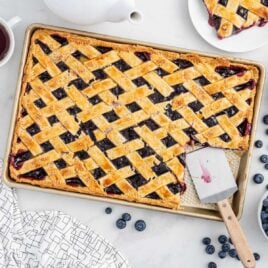Slab Pie
With a flaky crust and bubbling, warm fruit filling, this slab pie is a great way to enjoy pie when you are feeding a crowd.
Servings: 8
Calories: 678kcal
Ingredients
- 3 ready-made rolled pie crusts, from 2 (14.1-ounce) boxes (I used the Pillsbury brand)
- 42 ounces blueberry pie filling
- 1 tablespoon fresh lemon juice
- 1 teaspoon lemon zest
- ½ teaspoon almond extract
- 1 egg, room temperature
- 1 teaspoon water
- 2 teaspoons clear/white sanding sugar, large crystals
Instructions
- Preheat the oven to 425°F. You will need a 10x15-inch sized standard jelly roll pan.
- Remove your pie crusts from the refrigerator and let them come to room temperature, according to the package directions, before unrolling each crust. Once they can each be unrolled, you will lay two of the crusts, slightly overlapping in the center, onto your jelly roll pan so that you have about 2 to 3 inches or so of excess dough hanging off the shorter sides of the pan. Note: You may need to lightly flatten and thin out your rolled pie crust with a lightly floured rolling pin in order for them to fit your pan. I find that sometimes different brands (especially the generic ones) tend to be slightly smaller and thicker than the Pillsbury brand once unrolled.
- With a sharp paring knife, you will need to trim off the larger amount of excess dough hanging off the shorter ends of the pan.
- You will need to place those two pieces of excess dough, one on each of the longer sides of the pan, so that you fill in the gaps on the pan where the dough does not cover. You will want to face the rounded edge towards the center of the pan, and the straight edges will fill in the edges of the crust.
- With your fingers, gently press the dough to seal all the seams together, and tuck the border edges of the dough slightly under so that you have an even edge all around your pan.
- On a large piece of parchment paper, you will need to roll out your third crust, with a lightly floured rolling pin, to a rough rectangle (about 11x13 inches). With a sharp paring knife, cut strips approximately ½ to ¾ inches thick. Set aside.
- In a large mixing bowl, stir together the canned blueberry pie filling, lemon juice, lemon zest, and almond extract.
- Gently spoon the blueberry pie mixture into an even layer in the jelly roll pan.
- Using the strips of pie crust, you will create a lattice topping. Start with the longer pieces in the center and work your way out with the shorter pieces. Once you have placed all your lattice pieces onto the top of the sheet pan pie, you will want to press the edges together and crimp them. I like using the tines of a fork to press the edges down and make the crust pretty.
- Whisk together the egg and water in a small bowl to create an egg wash. Using a pastry brush, brush the entire crust with the egg wash.
- Sprinkle the sanding sugar crystals over the egg-washed crust.
- Bake for 30 to 35 minutes or until the crust is golden and the blueberry pie filling is bubbling.
- Allow the sheet pan pie to cool completely on the counter, at room temperature, before slicing and serving.
Notes
- You can place a larger, standard-sized sheet pan tray on the bottom rack of your oven to catch any pie filling that may ooze over the edge of the pie pan when baking and bubbling up.
- You may need to lightly flatten and thin out your rolled pie crust with a lightly floured rolling pin in order for them to fit your pan. I find that sometimes different brands (especially the generic ones) tend to be slightly smaller and thicker than the Pillsbury brand once unrolled.
- If you are new to creating a lattice pattern for your pies, you can find several tutorials online. If you find that some of your strips of dough are too long or not long enough, you can trim individual pieces to fit your pan. You can also use small cookie cutters to cut out small circles or other shapes to create a fun top for your pie.
- Oven temperatures vary and may need to be recalibrated periodically to ensure they are accurate. Make sure to check your pie at the lower end of the recommended baking time.
- Be sure to allow your sheet pan pie to cool completely before slicing and serving. If it is still warm, the filling will ooze when you remove your slice of pie. It will not give you a pretty slice. If you prefer your pie served warm, then you can reheat individual pieces.
Nutrition
Calories: 678kcal | Carbohydrates: 106g | Protein: 6g | Fat: 25g | Saturated Fat: 7g | Polyunsaturated Fat: 3g | Monounsaturated Fat: 12g | Trans Fat: 0.003g | Cholesterol: 20mg | Sodium: 326mg | Potassium: 259mg | Fiber: 5g | Sugar: 56g | Vitamin A: 63IU | Vitamin C: 2mg | Calcium: 61mg | Iron: 3mg
